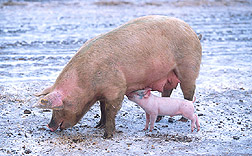New Feeder Curbs Pregnant Sows' Hoggish Ways
By Don Comis
July 15, 2002
An automated feeding system that eliminates the need for crating sows during their four-month pregnancies will be tested as part of a joint project involving the Agricultural Research Service, Texas Tech University in Lubbock and Automated Production Systems, Inc., of Assumption, Ill.
The feeding system, called "trickle feeding," allows sows to be kept in social groups in open pens. The system has been developed and tested in Europe, but this ARS-funded project will be the first complete evaluation of the system in North America.
ARS farm animal behavioralist Julie Morrow-Tesch will work with Texas Tech animal scientist John J. McGlone on the project. Morrow-Tesch is with the ARS Livestock Issues Research Unit in Lubbock, and the project is part of ARS' national research drive to improve animal handling practices. McGlone heads Texas Tech's Pork Industry Institute, which has a Sustainable Pork Farm for testing new practices.
Keeping sows in crates during pregnancy is being phased out in Europe. Many animal welfare and animal rights groups, consumers and food retailers in the United States also criticize crating because it doesn't allow sows much room and keeps them from enjoying social groupings. The crates protect sows from competition for food, ensuring all get equal rations.
The new feeding system promises to do the same, but without isolating animals. It uses a string of feed hoppers and dispensers to parcel out food to individual sows at the speed of the slowest eater. Faster eaters learn there is no advantage to leaving their dispensers.
The scientists are testing the system with social groups of five sows each. The sows are kept in a pen with free access to the feeding area. They run to the dispensers when they hear the distinctive whir signaling that the dispensing augers are turning.
ARS is the U.S. Department of Agriculture's chief scientific research agency.
|

